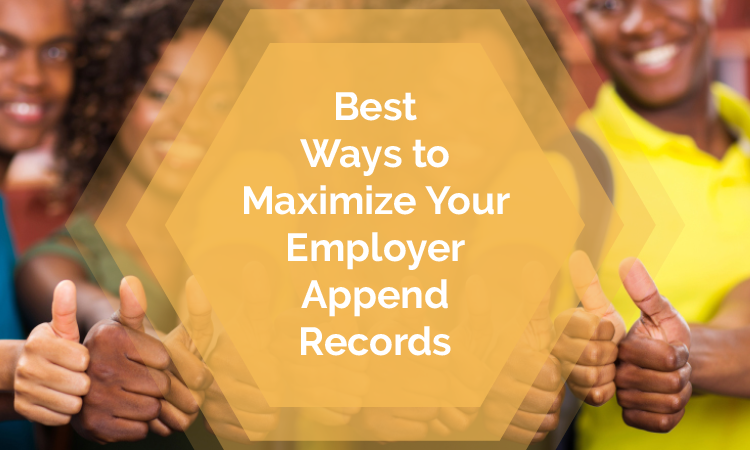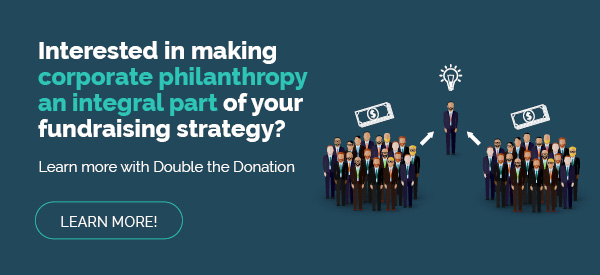
The more you know about your donors, the better you can relate to them and the stronger your relationships will be. One of the most essential pieces of the donor profile puzzle, however, is one that many organizations continue to lack: employment information.
Knowing where your donors work (and what roles they play in their companies) can provide your team with significant insights into corporate giving program eligibility, wealth levels, and more.
But how can you locate this data if you don’t already have access to it? That’s where employer appending comes in!
Employer appends are a specific form of data appending in which nonprofits seek additional information about their donors’ employment status. At the conclusion of the process, the organization receives more comprehensive donor profiles, complete with employer append records that allow fundraisers to utilize their supporters’ employment information.
In this guide, we’ll walk through four of the most impactful ways to make the most of employer appends. As a nonprofit fundraising professional, we recommend that you:
- Work with a nonprofit-specific data appending service.
- Provide as much donor information to start as possible.
- Keep your CRM clean, organized, and updated.
- Utilize matching gift software alongside employer appends.
Ready to elevate your donor engagement, overall fundraising, and corporate philanthropy efforts with employer append records? Explore four of our tried-and-true tips for locating and leveraging this information!
1. Work with a nonprofit-specific data appending service.
Effective employer appends are typically accomplished by working with a third-party data appending company. While there are a ton of available data appending companies to choose from, a smaller portion of these are dedicated to working with nonprofit organizations.
When you partner with a service provider that has substantial nonprofit experience, you can rest assured knowing that your donor data is in good hands. Specifically, you’ll know the appending company you choose is familiar with the types of data you need for successful nonprofit fundraising efforts and will prioritize your needs as such.
Once you’ve selected your nonprofit’s appends provider, you’ll equip them with the information you do have on your donors. The employer appends service will then scan the provided data against a combination of publicly available and privately held resources to begin filling in gaps in donor records.
In the end, you should receive employer information on a significant portion of your donor base.
2. Provide as much donor information to start as possible.
Data appending companies can provide large quantities of donor information, but they need to have basic details to begin with in order to get anywhere. That’s why employer appends experts recommend providing the third-party appending service with as much of the following fields as possible:
- Unique donor ID number
- Donor name
- Mailing address (home, business, or both)
- Region (state, city, and country)
- Email address(es)
- Phone number(s)
- College or university (with class year and major or degree)
- Most recent donation amount
- Date of last donation
- Date the entry was last updated (if known)
Keep in mind that the more information you initially provide your employer appending service, the more likely they will return with accurate and up-to-date information about your donors.
Here’s an example:
If all you have is a donor’s name (say, something like “John Smith”), it can be nearly impossible for the appending company to sift through all the available data. As a result, they may be unable to uncover your specific John Smith and his employer.
On the other hand, if you ask a data appends service to locate employment information for John Smith of Boston, Massachusetts, who graduated from Boston College in 1997 with a degree in econometrics and quantitative economics, you’ll be much more likely to narrow down the correct donor and end up with a precise employer append record.
While most nonprofits will not have access to all of the above data points for each donor, starting with a solid donor profile significantly increases the odds that you end up with beneficial employer append records.
3. Keep your CRM clean, organized, and updated.
New employer append records won’t be of much use to your team if your existing fundraising database is out of control. Without a clean database, it can be difficult to ensure your donor records are associated with the correct employer information. Not to mention, your nonprofit employees may be unable to find the data they need even if the information is hidden in there somewhere.
Following best practices like these can enable your organization to make the most of your available donor data and determine when the next steps are needed. Specifically, we recommend that you:
- Ensure consistent data formatting throughout your records. (For instance, how are names styled? Are street addresses abbreviated or spelled out in full?)
- Remove or combine duplicate records on a regular basis.
- Determine and manage inactive contacts (e.g., lapsed donors, deceased individuals, etc.).
- Identify donors with missing information (and make a plan for resolving the associated issues).
You’ll also want to set a cadence for how often your team should scan the information in your donor database to uncover any problem records or dirty data. After all, identifying donor information (whether employment-related or otherwise) is not a one-time task to cross off your to-do list and forget about it.
More than likely, your organization is always adding new records to your database while existing donors continue to change jobs, phone numbers, addresses, and more. Make sure you have a plan in place to stay on top of constant changes!
4. Utilize matching gift software alongside employer appends.
A data appending service is a great way to locate difficult information about your nonprofit donors—but it’s not the only way. Another top strategy for maximizing your employer append records involves leveraging matching gift software alongside your traditional appending service.
If you don’t already have a donor’s employment information on record, here’s how matching gift software can help:
- A donor gives to a nonprofit cause.
- The donor is given access to a matching gift employer database on the donation confirmation page or within an automated follow-up email.
- The donor interacts with the embedded company matching gift tool, conducting a quick search of their employer using the database widget.
- The donor is then provided with company-specific information on their employer’s matching gift program guidelines and submission instructions.
- The company the donor entered in the search tool is recorded and stored in your matching gift software portal and/or CRM as the individual’s employer.
For donors whose employment data you do have access to (whether through your matching gift software, employer append records, or another source.), here’s how matching gift automation can utilize that information for even greater results:
- Your organization triggers personalized matching gift fundraising appeals that contain employer-specific eligibility criteria and next steps.
- The donor opens this follow-up email to determine that their previously made donation to your organization is matching gift eligible.
- The individual navigates to their employer’s online matching gift submission forms to request a matching donation from their company.
- Your organization ultimately receives an additional “bonus” donation while simultaneously strengthening your relationship with the initial donor through personalized engagement and additional opportunities for support.
Increased corporate matching gifts are just one benefit of accurate and regularly updated employer append records. By pairing your data append strategies with matching gift fundraising, your organization will begin to see great results in both detailed donor data and boosted donation revenue.
Maximizing your organization’s workplace giving initiatives is one of the best ways to drive individual and corporate support simultaneously. Equipped with the information you need about your donors’ employment status, you’ll be all set to inform supporters about robust giving efforts, encourage donor participation, and target your highest-value philanthropic opportunities. And it all starts with well-built-out employer append records!
If you’d like to find out more about effective corporate fundraising strategies and initiatives, view our other additional resources below:
- Matching Gifts: The Ultimate Guide for Nonprofits in 2022. Employer append records enable your organization to better identify matching gift donors and prospects. Here’s how you can make the most of that information and drive more matches!
- Understanding the Matching Gift Disbursement Process. Once donors request corporate donation matches from their employers, the matching gift disbursement process takes place. Learn more about what happens behind the scenes with this guide.
- The Top 17 Matching Gift Companies | Our Favorite Picks. As you scan your employer append records, be sure to keep an eye out for companies like these top matching gift providers. Find out more about these particular generous businesses!
